by Paul Gilster | Jun 7, 2022 | Sail Concepts |
Knowing of Grover Swartzlander’s pioneering work on diffractive solar sails, I was not surprised to learn that Amber Dubill, who now takes the idea into a Phase III study for NIAC, worked under Swartzlander at the Rochester Institute of Technology. The Diffractive Solar Sailing project involves an infusion of $2 million over the next two years, with Dubill (JHU/APL) heading up a team that includes experts in traditional solar sailing as well as optics and metamaterials. A potential mission to place sails into a polar orbit around the Sun is one possible outcome.
[Addendum: The original article stated that the Phase III award was for $3 million. The correct amount is $2 million, as changed above].
But let’s fall back to that phrase ‘traditional solar sailing,’ which made me wince even as I wrote it. Solar sailing relies on the fact that while solar photons have no mass, they do impart momentum, enough to nudge a sail with a force that over time results in useful acceleration. Among those of us who follow interstellar concepts, such sails are well established in the catalog of propulsion possibilities, but to the general public, the idea retains its novelty. Sails fire the imagination: I’ve found that audiences love the idea of space missions with analogies to the magnificent clipper ships of old.
We know the method works, as missions like Japan’s IKAROS and NASA’s NanoSail-D2 as well as the Planetary Society’s LightSail 2 have all demonstrated. Various sail missions – NEA Scout and Solar Cruiser stand out here – are in planning to push the technology forward. These designs are all reflective and depend upon the direction of sunlight, with sail designs that are large and as thin as possible. What the new NIAC work will examine is not reflection but diffraction, which involves how light bends or spreads as it encounters obstacles. Thus a sail can be built with small gratings embedded within the thin film of its structure, and the case Swartzlander has been making for some time now is that such sails would be more efficient.
A diffractive sail can work with incoming light at a variety of angles using new metamaterials, in this case ‘metafilms,’ that are man-made structures with properties unlike those of naturally occurring materials. Sails made of them can be essentially transparent, meaning they will not absorb large amounts of heat from the Sun, which could compromise sail substrates.
Moreover, these optical films allow for lower-mass sails that are steered by electro-optic methods as opposed to bulky mechanical systems. They can maintain more efficient positions while facing the Sun, which also makes them ideal for the use of embedded photovoltaic cells and the collection of solar power. Reflective sails need to be tilted to achieve best performance, but the inability to fly face-on in relation to the Sun reduces the solar flux upon the sail.
The Phase III work for NIAC will take Dubill and team all the way from further analyzing the properties of diffractive sails into development of an actual mission concept involving multiple spacecraft that can collectively monitor solar activity, while also demonstrating and fine-tuning the sail strategy. The description of this work on the NIAC site explains the idea:
The innovative use of diffracted rather than reflected sunlight affords a higher efficiency sun-facing sail with multiplier effects: smaller sail, less complex guidance, navigation, and attitude control schemes, reduced power, and non-spinning bus. Further, propulsion enhancements are possible by the reduction of sailcraft mass via the combined use of passive and active (e.g., switchable) diffractive elements. We propose circumnavigating the sun with a constellation of diffractive solar sails to provide full 4? (e.g., high inclination) measurements of the solar corona and surface magnetic fields. Mission data will significantly advance heliophysics science, and moreover, lengthen space weather forecast times, safeguarding world and space economies from solar anomalies.
Delightfully, a sail like this would not present the shiny silver surface of the popular imagination but would instead create a holographic effect that Dubill’s team likens to the rainbow appearance of a CD held up to the Sun. And they need not be limited to solar power. Metamaterials are under active study by Breakthrough Starshot because they can be adapted for laser-based propulsion, which Starshot wants to use to reach nearby stars through a fleet of small sails and tiny payloads. The choice of sail materials that can survive the intense beam of a ground-based laser installation and the huge acceleration involved is crucial.
The diffractive sail concept has already been through several iterations at NIAC, with the testing of different types of sail materials. Grover Swartzlander received a Phase I grant in 2018, followed by a Phase II in 2019 to pursue the work, a needed infusion of funding given that before 2017, few papers on diffractive space sails existed in the literature. In a 2021 paper, Dubill and Swartzlander went into detail on the idea of a constellation of sails monitoring solar activity. From the paper:
We have proposed launching a constellation of satellites throughout the year to build up a full-coverage solar observatory system. For example a constellation of 12 satellites could be positioned at 0.32 AU and at various inclinations about the sun within 6 years: Eight at various orbits inclined by 60 and four distributed about the solar ecliptic. We know of no conventionally powered spacecraft that can readily achieve this type of orbit in such a short time frame. Based on our analysis, we find that diffractive solar sails provide a rapid and cost-effective multi-view option for investigating heliophysics.
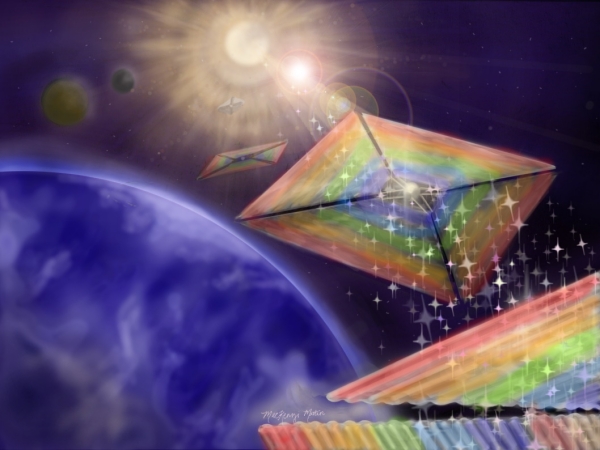
Image: The new Diffractive Solar Sailing concept uses light diffraction to more efficiently take advantage of sunlight for propulsion without sacrificing maneuverability. Incidentally, this approach also produces an iridescent visual effect. Credit: RIT/?MacKenzi Martin.
Dubill thinks an early mission involving diffractive sails can quickly prove their value:
“While this technology can improve a multitude of mission architectures, it is poised to significantly impact the heliophysics community’s need for unique solar observation capabilities. Through expanding the diffractive sail design and developing the overall sailcraft concept, the goal is to lay the groundwork for a future demonstration mission using diffractive lightsail technology.”
A useful backgrounder on diffractive sails and their potential use in missions to the Sun is Amber Dubill’s thesis at RIT, “Attitude Control for Circumnavigating the Sun with Diffractive Solar Sails” (2020), available through RIT Scholar Works. See also Dubill & Swartzlander, “Circumnavigating the sun with diffractive solar sails,” Acta Astronautica
Volume 187 (October 2021), pp. 190-195 (full text). Grover Swartzlander’s presentation “Diffractive Light Sails and Beam Riders,” is available on YouTube.

by Paul Gilster | Apr 26, 2022 | Sail Concepts |
Not long ago we looked at Greg Matloff’s paper on von Neumann probes, which made the case that even if self-reproducing probes were sent out only once every half million years (when a close stellar encounter occurs), there would be close to 70 billion systems occupied by such probes within a scant 18 million years. Matloff now considers interstellar migration in a different direction in a new paper addressing how M-dwarf civilizations might expand, and why electric sails could be their method.
It’s an intriguing notion because M-dwarfs are by far the most numerous stars in the galaxy, and if we learn that they can support life, they might house vast numbers of civilizations with the capability of sending out interstellar craft. They’re also crippled in terms of electromagnetic flux when it comes to conventional solar sails, which is why the electric sail comes into play as a possible alternative, here analyzed in terms of feasibility and performance and its prospects for enabling interstellar migration.
The term ‘sail’ has to be qualified. By convention, I’ve used ‘solar sail,’ for example, to describe sails that use the momentum imparted by stellar photons – Matloff often calls these ‘photon sails,’ which is also descriptive, though to my mind, a ‘photon sail’ might describe both a beam-driven as well as a stellar photon-driven sail. Thus I prefer ‘lightsail’ for the beamed sail concept. In any case, we have to distinguish all these concepts from the electric sail, which operates on fundamentally different principles.
In our Solar System, a sail made of absorptive graphene deployed from 0.1 AU could achieve a Solar System escape velocity of 1000 kilometers per second, and perhaps better if the mission were entirely robotic and not dealing with fragile human crews. The figure seems high, but Matloff gave the calculations in a 2012 JBIS paper. The solar photon sail wins on acceleration, and we can use the sail material to provide extra cosmic ray shielding enroute. These are powerful advantages near our own Sun.
But the electric sail has advantages of its own. Rather than drawing on the momentum imparted by solar photons (or beamed energy), an electric sail rides the stellar wind emanating from a star. This stream of charged particles has been measured in our system (by the WIND spacecraft in 1995) as moving in the range of 300 to 800 kilometers per second at 1 AU, a powerful though extremely turbulent and variable force that can be applied to a spacecraft. Because an interstellar craft entering a destination system would also encounter a stellar wind, an electric sail can be deployed for deceleration, something both forms of sail have in common.
How to harness a stellar wind? Matloff first references a 2008 paper from Pekka Janhunen (Finnish Meteorological Institute) and team that described long tethers (perhaps reaching 20 kilometers in length) extended from the spacecraft, each maintaining a steady electric potential with the help of a solar-powered electron gun aboard the vehicle. As many as a hundred tethers — these are thinner than a human hair — could be deployed to achieve maximum effect. While the solar wind is far weaker than solar photon pressure, an electric sail of this configuration with tethers in place can create an effective solar wind sail area of several square kilometers.
We need to maintain the electric potential of the tethers because it would otherwise be compromised by solar wind electrons. The protons in the solar wind – again, note that we’re talking about protons, not photons – reflect off the tethers to drive us forward.

Image: Image of an electric sail, which consists of a number (50-100) of long (e.g., 20 km), thin (e.g., 25 microns) conducting tethers (wires). The spacecraft contains a solar-powered electron gun (typical power a few hundred watts) which is used to keep the spacecraft and the wires in a high (typically 20 kV) positive potential. The electric field of the wires extends a few tens of meters into the surrounding solar wind plasma. Therefore the solar wind ions “see” the wires as rather thick, about 100 m wide obstacles. A technical concept exists for deploying (opening) the wires in a relatively simple way and guiding or “flying” the resulting spacecraft electrically. Credit: Artwork by Alexandre Szames. Caption via Pekka Janhunen/Kumpula Space Center.
For interstellar purposes, we look at much larger spacecraft, bearing in mind that once in deep space, we have to turn off the electron gun, because the interstellar medium can itself decelerate the sail. Operating from a Sun-like star, the electric sail generation ship Matloff considers is assumed to have a mass of 107 kg, assuming a constant solar wind within the heliosphere of 600 kilometers per second. The variability of the solar wind is acknowledged, but the approximations are used to simplify the kinematics. The paper then goes on to compare performance near the Sun with that near an M-dwarf star.
We wind up with some interesting conclusions. First of all, an interstellar mission from a G-class star like our own would be better off using a different method. We can probably reach an interstellar velocity of as high as 70 percent of this assumed constant solar wind velocity (Matloff’s calculations), but graphene solar sails can achieve better numbers. And if we add in the variability of the solar wind, we have to be ready to constantly alter the enormous radius of the electric field to maintain a constant acceleration. If we’re going to send generation ships from the Sun, we’re most likely to use solar sails or beamed lightsails.
But things get different when we swing the discussion around to red dwarf stars. In The Electric Sail and Its Uses, I described a paper from Avi Loeb and Manasvi Lingam in 2019 that studied electric sails using the stellar winds of M-dwarfs, with repeated encounters with other such stars to achieve progressively higher speeds. Matloff agrees that electric sails best photon sails in the red dwarf environment, but adds useful context.
Let’s think about generation ships departing from an M-dwarf. Whereas the electromagnetic flux from these stars is far below that of the Sun, the stellar wind has interesting properties. We learn that it most likely has a higher mass density (in terms of rate per unit area) than the Sun, and the average stellar wind velocity is 500 kilometers per second. Presumably a variable electric field aboard the craft could adjust to maintain acceleration as the vehicle moves outward from the star, although the paper doesn’t get into this. The author’s calculations show an acceleration, for a low-mass spacecraft about 1 AU from the Sun, of 7.6 × 10?3 m/s2 , or about 7.6 × 10?4 g. Matloff considers this a reasonable acceleration for a worldship.
So while low electromagnetic pressure makes photon sails far less effective at M-dwarfs as opposed to larger stars, electric sails remain in the mix for civilizations willing to contemplate generation ships that take thousands of years to reach their goal. In an earlier paper, the author considered close stellar encounters, pointing out that 70,000 years ago, the binary known as Scholz’s Star (it has a brown dwarf companion) passed within 52,000 AU of the Sun. We can expect another close pass (Gliese 710) in about 1.35 million years, this one closing to a perihelion of 13,365 AU. From the paper:
Bailer?Jones et al. have used a sample of 7.2 million stars in the second Gaia data release to further investigate the frequency of close stellar encounters. The results of this analysis indicate that seven stars in this sample are expected to approach within 0.5 parsecs of the Sun during the next 15 million years. Accounting for sample incompleteness, these authors estimate that about 20 stars per million years approach our solar system to within 1 parsec. It is, therefore, inferred that about 2.5 encounters within 0.5 parsecs will occur every million years. On average, 400,000 years will elapse between close stellar encounters, assuming the same star density as in the solar neighborhood.
If interstellar missions were only attempted during such close encounters, we still have a mechanism for a civilization to use worldships to expand into numerous nearby stellar systems. It would take no more than a few star-faring civilizations around the vast number of M-dwarfs to occupy a substantial fraction of the Milky Way, even without the benefits of von Neumann style self-reproduction. With the number of planetary systems occupied doubling every 500,000 years, and assuming a civilization only sends out a worldship during close stellar encounters, we get impressive results. In the clip below, n = the multiple of 500,000 years. The number of systems occupied is P:
At the start, n = 0 and P = 1. When 500,000 years have elapsed, the hypothetical spacefaring civilization makes the first transfer, n = 1 and P = 2. After one million years (n = 2), both the original and occupied stellar systems experience a close stellar encounter, migration occurs and P = 4. After a total elapsed time of 1.5 million years, n = 3 and they occupy eight planetary systems. When n = 5, 10 and 20 the hypothetical civilization has respectively occupied 32, 1024 and 1,048,576 planetary systems.
With M-dwarfs being such a common category of star, learning more about their systems’ potential habitability will have implications for the possible spread of technological societies, even assuming propulsion technologies conceivable to us today. What faster modes may eventually become available we cannot know.
The paper is Matloff, “The Solar?Electric Sail: Application to Interstellar Migration and Consequences for SETI,” Universe 8(5) (19 April 2022), 252 (full text). The Lingam and Loeb paper is “Electric sails are potentially more effective than light sails near most stars,” Acta Astronautica Volume 168 (March 2020), 146-154 (abstract).

by Paul Gilster | Apr 12, 2022 | Sail Concepts |
Centauri Dreams tracks ongoing work on beamed sails out of the conviction that sail designs offer us the best hope of reaching another star system within this century, or at least, the next. No one knows how this will play out, of course, and a fusion breakthrough of spectacular nature could shift our thinking entirely – so, too, could advances in antimatter production, as Gerald Jackson’s work reminds us. But while we continue the effort on all alternative fronts, beamed sails currently have the edge.
On that score, take note of a soon to be available two-volume set from Philip Lubin (UC-Santa Barbara), which covers the work he and his team have been doing under the name Project Starlight and DEEP-IN for some years now. This is laser-beamed propulsion to a lightsail, an idea picked up by Breakthrough Starshot and central to its planning. The Path to Transformational Space Exploration pulls together Lubin and team’s work for NASA’s Innovative Advanced Concepts office, as well as work funded by donors and private foundations, for a deep dive into where we stand today. The set is expensive, lengthy (over 700 pages) and quite technical, definitely not for casual reading, but those of you with a nearby research library should be aware of it.
Just out in the journal Communications Materials is another contribution, this one examining the structure and materials needed for a lightsail that would fly such a mission. Giovanni Santi (CNR/IFN, Italy) and team are particularly interested in the question of layering the sail in an optimum way, not only to ensure the best balance between efficiency and weight but also to find the critical balance between reflectance and emissivity, because we have to build a sail that can survive its acceleration.
What this boils down to is that we are assuming a laser phased array producing a beam that is applied to an extremely thin, lightweight structure, with the intention of reaching a substantial percentage (20 percent) of lightspeed. The laser flux at the spacecraft is, the paper notes, on the order of 10 – 100 GW m-2, with the sail no further from the Earth than the Moon. Lubin’s work at UC-Santa Barbara (he is a co-author here) has demonstrated a directed energy source with emission at 1064 nm.
Thermal issues are critical. The sail has to survive the temperature increases of the acceleration phase, so we need materials that offer high reflectance as well as the ability to blow off that heat, meaning high emissivity in the infrared. The Santa Barbara laboratory work has used ytterbium-doped fiber laser amplifiers in what the paper describes as a ‘master oscillator phased array’ topology. And this gets fascinating from the relativistic point of view. Remember, we are trying to produce a spacecraft that can make the journey to a nearby star in a matter of decades, so relativistic effects have to be considered.
In terms of the sail itself, that means that our high-speed spacecraft will quickly see a longer wavelength in the beamed energy than was originally emitted. This is true despite the fact that the period of acceleration is short, on the order of minutes.
The authors suggest that there are two ways to cope with this. The laser can shorten its emission wavelength as the spacecraft accelerates, meaning that the received wavelength is constant. But the paper focuses on a second option: Make the reflecting surface broadband enough to allow a fairly large range of received wavelengths.
Thus the core of this paper is an analysis of the materials possible for such a sail and their thermal properties, keeping this wavelength change in mind, while at the same time studying – after the operative laser wavelength is determined – how the structure of the lightsail can be engineered to survive the extremities of the acceleration phase.
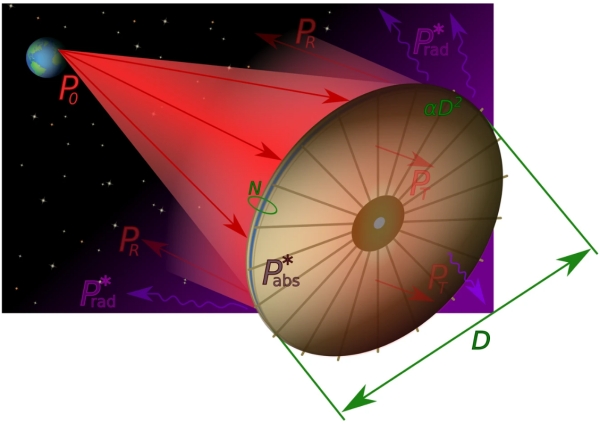
Image: This is Figure 1 from the paper. Caption: The red arrows denote the incident, transmitted and reflected laser power, while the violet ones indicate the thermal radiation leaving the structure from the front and back surfaces. The surface area is modeled as ?D2; ??=?1 for a squared lightsail of side D and ??=??/4 for a circular lightsail of diameter D. Credit: Santi et al.
The paper considers a range of possible materials for the sail, all of them low in density and widely used, so that their optical parameters are readily available in the literature. Optimization is carried out for stacks of different materials in combination to find structures with maximum optical properties and highest performance. Critical parameters are the reflectance and the areal density of the resulting sail.
Out of all this, titanium dioxide (TiO2) stands out in terms of thermal emission. This work suggests a combination of stacked materials:
The most promising structures to be used with a 1064?nm laser source result to be the TiO2-based ones, in the form of single layer or multilayer stack which include the SiO2 as a second material. In term of propulsion efficiency, the single layer results to be the most performing, while the multilayers offer some advantages in term[s] of thermal control and stiffness. The engineering process is fundamental to obtain proper optical characteristics, thus reducing the absorption of the lightsail in the Doppler-shifted wavelength of the laser in order to allow the use of high-power laser up to 100 GW. The use of a longer wavelength laser source could expand the choice of potential materials having the required optical characteristics.
So much remains to be determined as this work continues. The required mechanical strength of the multilayer structure means we need to learn a lot more about the properties of thin films. Also critical is the stability of the lightsail. We want a sail that survives acceleration not only physically but also in terms of staying aligned with the axis of the beam that is driving it. The slightest imperfection in the material, induced perhaps in manufacturing, could destroy this critical alignment. A variety of approaches to stability have emerged in the literature and are being examined.
The take-away from this paper is that thin-film multilayers are a way to produce a viable sail capable of being accelerated by beamed energy at these levels. We already have experience with thin films in areas like the coatings deposited on telescope mirrors, and because the propulsion efficiency is only slightly affected by the angle at which the beam strikes the sail, various forms of curved designs become feasible.
Can a sail survive the rigors of a journey through the gas and dust of the interstellar medium? At 20 percent of c, the question of how gas accumulates in materials needs work, as we’d like to arrive at destination with a sail that may double as a communications tool. Each of these areas, in turn, fragments into needed laboratory work on many levels, which is why a viable effort to design a beamed mission to a star demands a dedicated facility focusing on sail materials and performance. Breakthrough Starshot seems ideally placed to make such a facility happen.
The paper is Santi et al., “Multilayers for directed energy accelerated lightsails,” Communications Materials 3 (16 (2022). Abstract.

by Paul Gilster | Mar 1, 2022 | Sail Concepts |
The continuing release of papers related to or referring to the Breakthrough Starshot sail concept is good news for the entire field. Interstellar studies as an academic discipline has never had this long or sustained a period of activity, and the growing number of speakers at space-related conferences attests to the current vitality of starflight among professionals and the general public alike.
Not all interstellar propulsion concepts involve laser-beaming, of course, and we’ll soon look at what some would consider an ever more exotic concept. But today I’m focusing on a paper from Ho-Ting Tung and Artur Davoyan, both in the Mechanical and Aerospace Engineering Department at UCLA. You could say that these two researchers are filling in some much needed space between the full-bore interstellar effort of Breakthrough Starshot, the Solar System-oriented laser work of Andrew Higgins’ team at McGill, and much smaller, near-term experiments we could run not so far from now.
Of the many potential show-stoppers faced by a mission to another star at our stage of development is the need to develop the colossal laser array envisioned by Starshot. The Higgins array is at a smaller scale, as befits a concept with nearby targets like Mars. What Tung and Davoyan envision are tiny payloads (here they parallel Breakthrough), some no more than a gram in mass, but the authors push the sail with a 100 kW array about a meter in size. Compare this with Breakthrough’s need for a gigantic square-kilometer array of 10 kW lasers with a combined output of up to 100 GW.
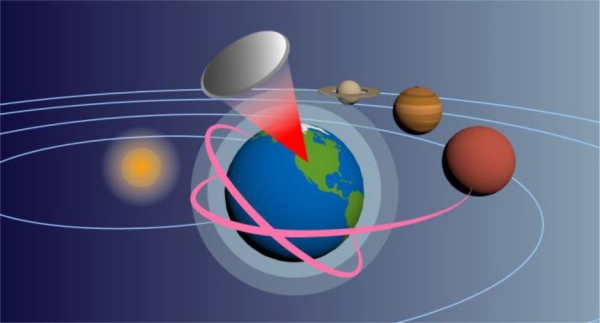
Image: In this illustration, a low-power laser (red cone) on Earth could be used to shift the orbit (red lines) of a small probe (grey circle), or propel it at rapid speeds to Neptune and beyond. Credit: Ho-Ting Tung et al.
The UCLA work takes us to a consideration of operations with spacecraft in Earth orbit as well as payloads sent on interplanetary trajectories. Thus we are in the realm of the kind of missions that today would demand chemical or electric propulsion, and we are looking at a system that might be used, for example, for orbital adjustment of Earth satellites after launch, or in the case of chip-class payloads, interplanetary missions with surprising velocities, up to 5 times that of New Horizons. As noted, the needed laser aperture is, by the standards of the missions we’ve discussed earlier, small:
…a sail with w = 1 m would require a laser with an aperture D ? 26 m (compare with the 30 m diameter primary mirror of the Thirty Meter Telescope under construction). However, we stress that most practical scenarios are limited to low and medium Earth orbits that require a much shorter operation range (z ? 1000km), and therefore a significantly smaller laser array.
Indeed, an array a meter in size could be efficient, maneuvering small satellites in Earth orbit, or being used to bring small chip-craft up to Solar System escape velocity. Thus we have the potential to create laser propulsion experiments and missions with array powers of ? 100 kW and array sizes that do not require kilometers of desert for their construction. Payloads can range from 1 to 100 grams depending on the mission, though the focus here is wafer-scale, on the order of 10 centimeters.
As to sail materials, the authors calculate that for maximum reflectivity coupled with rapid cooling, silicon nitride and boron nitride are the materials of choice:
Broadband spectral emissivity of silicon nitride…results in a better heat rejection (i.e., lower temperature) as compared [to] narrow band BN thermal emitters. However, boron nitride being lighter than silicon nitride allows design of very light-weight light-sails, which eventually translates onto higher velocity gain, ?v.
The paper offers possible ways to create these structures, including using metamaterials formed into nanostructured architectures with nanometer-scale ‘sandwich’ panels between material layers, or using ‘micro pillars’ within the photonic structure.
The broader picture is that we’re mapping out how to experiment with lasers and materials that may begin moving up the ladder of mission complexity. There are innumerable issues to be overcome, but the early theoretical work is crucial to making what may become an interplanetary infrastructure a reality. These examinations should also feed into the ambitious work on projects that aim at interstellar missions.
The paper is Ho-Ting Tung et al, Low-Power Laser Sailing for Fast-Transit Space Flight, Nano Letter,” Nano Letters 22, 3 (31 January 2022), 1108–1114 (abstract).

by Paul Gilster | Feb 24, 2022 | Sail Concepts |
One of the benefits of a project like Breakthrough Starshot is that it moves the ball forward in terms of the academic research that underpins advances in technologies. I seriously doubt that Starshot will result in an Alpha Centauri probe reaching these stars within the next 50 years, given among other things the conundrum of data retrieval from a fleet of chip-sized micro-craft. But we all gain from the fact that scientists are tackling these issues in a well-funded and coordinated way. The research library grows.
As a field, interstellar studies has always been resource-starved, not to mention winning scant attention among the larger community of scientists and engineers at conferences and in publications. But it has drawn on a consistent thread of interest that now gains new energies. That benefits the entire effort. And let’s not forget the power of looking far into the future to get a conception of what we can do with scaled-down projects in the near term, as for example Andrew Higgins’ laser-fed fast missions to Mars.
Starshot, of course, takes the laser concept into the interstellar realm, using a massive ground-based array that would likely be based in Chile’s Atacama Desert. The laser array is used to push meter-scale sails, making Starshot’s committee on sail design a major component of the effort. The infusion of funding into sail technologies is welcome, as it leads to new insights into a sail’s shape, its size and its materials.
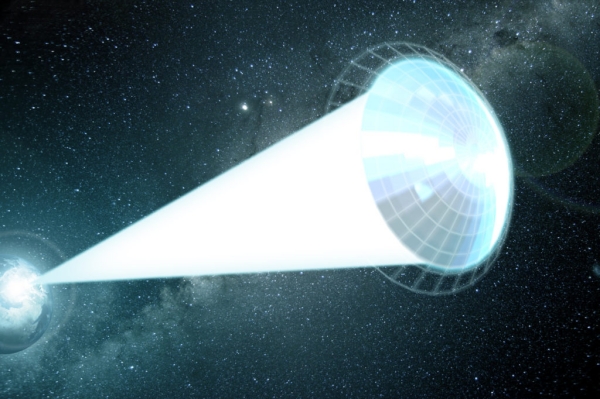
Image: An artist’s conception of the Starshot Lightsail spacecraft during acceleration by a ground-based laser array. Previous conceptions of lightsails have imagined them being passively pushed by light from the sun, but Starshot’s laser-based approach requires rethinking the sail’s shape and composition so it won’t melt or tear during acceleration. Credit: Masumi Shibata, courtesy of Breakthrough Initiatives.
Thus the significance of Igor Bargatin’s work. An associate professor at the University of Pennsylvania in the Department of Mechanical Engineering and Applied Mechanics, Bargatin and colleagues at the university as well as at UCLA have just published two papers going through fundamental sail issues and specifications. Remember that the projected sails, perhaps three-meters wide and a thousand times thinner than a sheet of paper, are to be subjected to a light intensity millions of times that of the Sun.
The team sees these sails as being made of ultrathin sheets of aluminum oxide and molybdenum disulfide, constructed in a parachute shape rather than a flat surface. The structure would be about as deep as it is wide, allowing the greatest ability under these calculations of withstanding the strain of the sudden acceleration, which is expected to reach tens of thousands of g’s. A ‘billowing’ sail should hold up to the strain better than a tight, flat one, providing a surface that is more resistant to tears.
Matthew Campbell is a postdoctoral researcher in Bargatin’s group and lead author of the paper covering the sail’s shape:
“Laser photons will fill the sail much like air inflates a beach ball. And we know that lightweight, pressurized containers should be spherical or cylindrical to avoid tears and cracks. Think of propane tanks or even fuel tanks on rockets.”
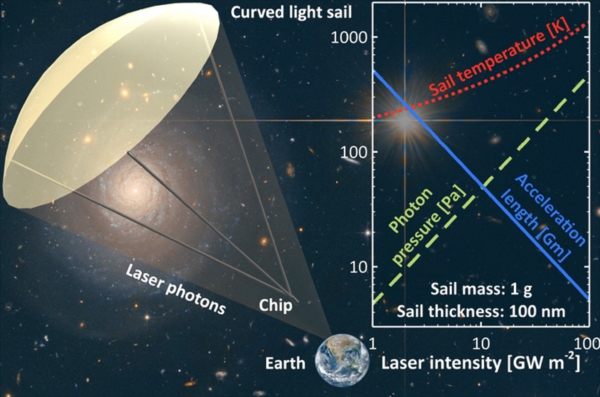
Image: Campbell et al. show that the diameter and radius of curvature of a circular light sail should be comparable in magnitude, both on the order of a few meters, in optimal designs for gram-scale payloads. Credit: Campbell et al.
The second paper, led by UCLA engineer Aaswath Raman, examines sail materials, offering insights into how heat will be dissipated under the powerful laser beam. Here the idea is to use nano-scale patterning within the material to manage the heat. Says Raman:
“If the sails absorb even a tiny fraction of the incident laser light, they’ll heat up to very high temperatures. To make sure they don’t just disintegrate, we need to maximize their ability to radiate their heat away, which is the only mode of heat transfer available in space.”
While earlier research maximized heat dissipation through a photonic crystal design that deployed regularly spaced holes in the sail material, the new work suggests adding a grid-like pattern for the ‘fabric,’ with the spacing of the holes matching the wavelength of light, and the swatches of sail material forming the grid spaced to match the wavelength of the thermal emission. The result is a stronger sail, one that could endure a higher initial thrust and therefore need less time under the beam.
The mathematics involved here is of a complexity far above my pay grade. I’ll have to send you to the paper for the details. But I think we can visualize the sail internals as a kind of ‘scaffolding’ that is apparent in the image below. The reference to ‘Mie resonant features’ in the caption to this image points to the work of Gustav Mie, who described what we now call ‘Mie scattering,’ showing the behavior of light of various wavelengths as it strikes particular kinds of structures. Mie resolved the intricate mathematics of these interactions.
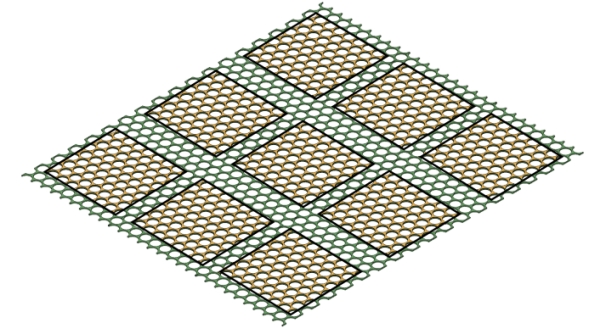
Image: This is Figure S4 from the paper. Caption: Continuous Mie structure design. The black outlines serve to highlight the positions of the Mie resonant features against the continuous reflective green layer, but would not exist in the actual design. Credit: Brewer et al.
UCLA’s Deep Jariwala, who was involved with both papers, comments:
“A few years ago, even thinking or doing theoretical work on this type of concept was considered far-fetched. Now, we not only have a design, but the design is grounded in real materials available in our labs. Our plan for the future would be to make such structures at small scales and test them with high-power lasers.”
Thus the theoretical work continues. Exactly when it pays off in hardware and actual missions is something we cannot know.
The papers are Campbell et al., “Relativistic Light Sails Need to Billow,” Nano Letters 22, 1 (2022), 90-96 (abstract); and Brewer et al., “Multiscale Photonic Emissivity Engineering for Relativistic Lightsail Thermal Regulation,” Nano Letters 22, 2 (2022), 594-601 (abstract).

by Paul Gilster | Jan 24, 2022 | Sail Concepts |
2020 GE is an interesting, and soon to be useful, near-Earth asteroid. Discovered in March of 2020 through the University of Arizona’s Catalina Sky Survey, 2020 GE is small, no more than 18 meters or so across, placing it in that class of asteroids below 100 meters in size that have not yet been examined up close by our spacecraft. Moreover, this NEA will, in September of 2023, obligingly make a close approach to the Earth, allowing scientists to get that detailed look through a mission called NEA Scout.
This is a mission we’ve looked at before, and I want to stay with it because of its use of a solar sail. Scheduled to be launched with the Artemis 1 test flight using the Space Launch System (SLS) rocket no earlier than March of this year, NEA Scout is constructed as a six-unit CubeSat, one that will be deployed by a dispenser attached to an adapter ring connecting the rocket with the Orion spacecraft. After separation, the craft will unfurl a sail of 86 square meters, deployed via stainless steel alloy booms. It is one of ten secondary payloads to be launched aboard the SLS on this mission.
Les Johnson is principal technology investigator for NEA Scout at Marshall Space Flight Center in Huntsville:
“The genesis of this project was a question: Can we really use a tiny spacecraft to do deep space missions and produce useful science at a low cost? This is a huge challenge. For asteroid characterization missions, there’s simply not enough room on a CubeSat for large propulsion systems and the fuel they require.”
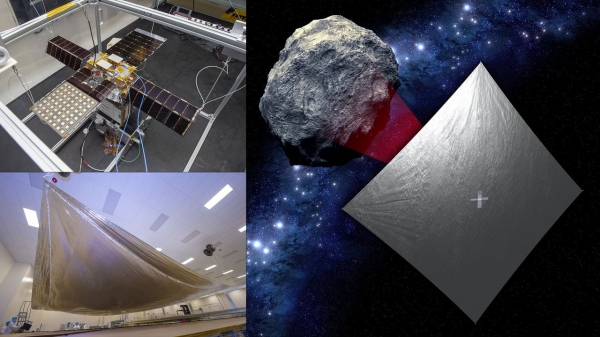
Image: NEA Scout is composed of a small, shoebox-sized CubeSat (top left) and a thin, aluminum-coated solar sail about the size of a racquetball court (bottom left). After the spacecraft launches aboard Artemis I, the sail will use sunlight to propel the CubeSat to a small asteroid (as depicted in the illustration, right). Credit: NASA.
A solar sail ought to be made to order if the objective is eventual high performance within the constraints of low mass and low volume. Reflecting solar photons and also using small cold-gas thrusters for maneuvers and orientation, NEA Scout will be investigating a near-Earth asteroid in a size range that is far more common than the larger NEAs we’ve thus far studied. It’s worth remembering that the Chelyabinsk impactor was about 20 meters in diameter, and in the same class as 2020 GE.
The 2023 close approach to Earth will occur at a time when NEA Scout will have used a gravitational assist from the Moon to alter its trajectory to approach the asteroid. Julie Castillo-Rogez, the mission’s principal science investigator at JPL, says that the spacecraft will achieve a slow flyby with relative speed of less than 30 meters per second. Using a camera with a resolution of 10 centimeters per pixel, scientists should be able to learn much about the object’s composition – a clump of boulders and dust (think Bennu, as investigated by OSIRIS-REx), or a solid object more like a boulder?
Bear in mind that NEA Scout fits into a continuum of solar sail development, with NASA’s Advanced Composite Solar Sail System (ACS3) the next to launch, demonstrating new, lightweight boom deployment techniques from a CubeSat. The unfurled square sail will be approximately 9 meters per side. As we haven’t looked at this one before, let me add this, from a NASA fact sheet:
The ACS3’s sails are supported and connected to the spacecraft by booms, which function much like a sailboat’s boom that connects to its mast and keeps the sail taut. The composite booms are made from a polymer material that is flexible and reinforced with carbon fiber. This composite material can be rolled for compact stowage, but remains strong and lightweight when unrolled. It is also very stiff and resistant to bending and warping due to changes in temperature. Solar sails can operate indefinitely, limited only by the space environment durability of the solar sail materials and spacecraft electronic systems. The ACS3 technology demonstration will also test an innovative tape-spool boom extraction system designed to minimize jamming of the coiled booms during deployment.
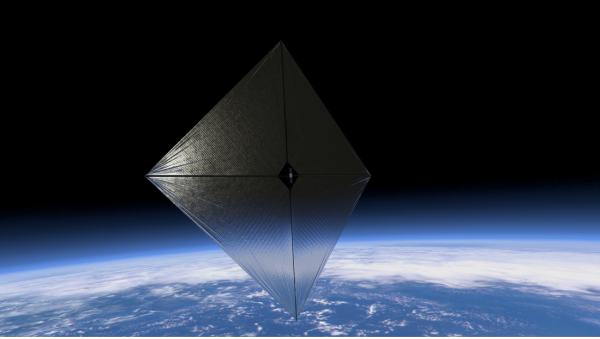
Image: An illustration of a completely unfurled solar sail measuring approximately 9 meters per side. Since solar radiation pressure is small, the solar sail must be large to efficiently generate thrust. Credit: NASA.
ACS3 is scheduled for liftoff later in 2022 as part of a rideshare mission on Rocket Lab’s Electron launch vehicle from its Launch Complex 1 in New Zealand. Beyond ACS3 looms Solar Cruiser, which takes the sail size up to 1,700 square meters in 2025, a mission we’ve looked at before and will continue to track as NASA attempts to launch the largest sail ever tested in space.













